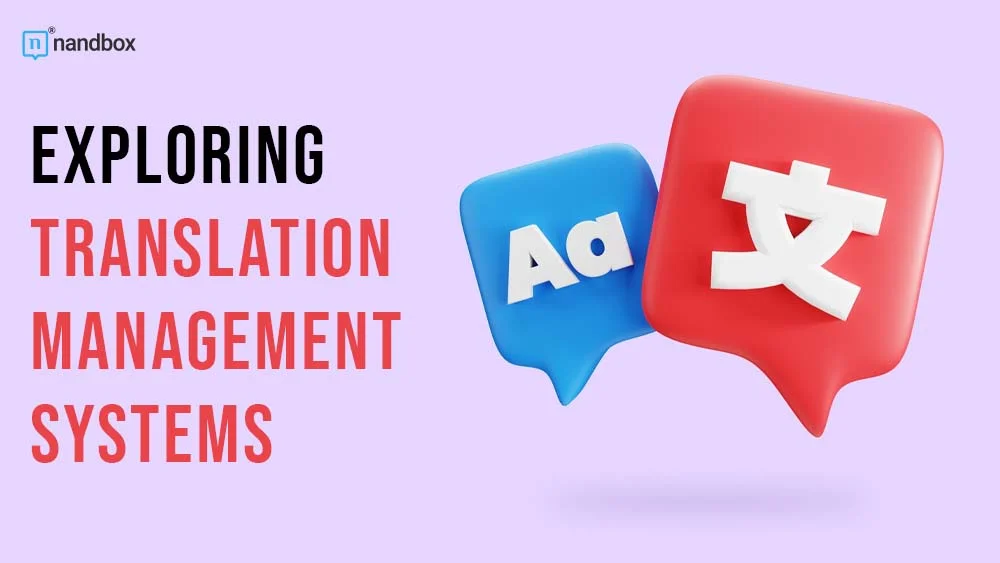Exploring Translation Management Systems: A Thorough Overview of Key Concepts and Features
Globalization paved the way for vibrant economic exchange between countries. To facilitate that exchange, business translation services stepped in. Translation agencies help companies to overcome linguistic barriers by offering precise and accurate translations. However, mere talent is not enough to create such translations. You need professional tools to orchestrate, manage, and streamline the translation process. You need a translation management system. This post will teach you everything there’s to know about modern translation management systems and how to choose one for your business.
What is a translation management system?
A translation management system (TMS) is software facilitating text translation. Such systems come with a comprehensive set of management, automation, and quality assurance tools, making them indispensable for both translators and project managers.
Unlike, simple translation tools, the TMS come allows managers to control localization projects from start to finish. They can assign tasks to individual translators who can remotely access glossaries and other resources. No specialized software is required for unimpeded access, just a simple web browser.
Thanks to the TMS, project managers can easily control the cost, delivery, and quality assurance of sprawling localization projects. Thus, the TMS allows to launch multilingual websites and apps faster and on a budget.
What are the TMS benefits?
To translate a single document from one language to another all you need is a good translator. However, most translation projects contain multiple documents and may involve translation into several languages. A translation project with a large amount of content requires careful management and orchestration to ensure consistency and alignment with your business goals.
The translation management system makes tracking progress easy for all users, including senior executives, managers, and localization specialists. Let’s examine this and other benefits in greater detail.
Benefits for senior executives
Senior executives must control their organization’s global communications strategy while protecting intellectual property and managing costs. TMS offers a robust solution to protect sensitive data and streamline the localization process for faster time-to-market at lower costs. These capabilities enable staying competitive in global markets, optimizing operational efficiency, and making informed decisions based on comprehensive analytics and reporting tools.
| Database control and intellectual property protection | TMS is critical in preventing data breaches by centralizing and protecting all translation-related activities in a single platform. It minimizes the risk of unauthorized access by storing sensitive information and translated content in a secure cloud environment. Advanced permission settings ensure that only authorized personnel can view and edit certain documents, protecting sensitive data. In addition, automating workflows in the TMS reduces the need for external file sharing, reducing the likelihood of data leakage. |
| Fast speed and low price | You get an opportunity to reduce the final price for the work and a reduced timeframe for the finished project with its introduction to the market. It applies mainly to large-scale projects, for which you must consider many critical issues: meeting deadlines and complying with all requirements and standards related to the specifics of a particular language. It is not uncommon for the localization process to change the entire result due to constant adjustments to the product files. Thanks to the capabilities of the translation management system, you can track the fulfillment of specific tasks and manage the entire process, reducing the time of order fulfillment and, consequently, the cost of work. And this may happen soon, as translation service providers pay for repeat segments at a lower rate. |
| Simplified statistics retrieval | As a rule, all translation management systems use tools based on an SQL database. It is where all the data about the projects is stored. Therefore, it becomes much easier and faster to create reports, track changes, and constantly monitor them. And you no longer have to search for statistics in endless company files or email lists. You will have quick access to it all and can easily use it to generate reports. |
Benefits for localization managers
Localization managers are responsible for smoothly executing translation projects and meeting customer requirements and deadlines. TMS provides seamless access to project progress, increasing efficiency through automation and seamlessly blending machine translation with human expertise. It allows for better management of the localization process and enables high-quality translations that are culturally and contextually sensitive to the target audience.
| Unhindered access to current results and implementation schedules | Localization specialists receive an order to work on. Still, it remains under the close attention of managers. Any adjustments made to the terms of processing the order and compliance with the conditions of the customer will not only fall on the shoulders of localization specialists but also be fixed by managers. |
| Increased efficiency through automation | For example, the system can automatically assign translation jobs to the most appropriate translators based on their experience, availability, and previous performance. It can also track project progress in real-time, automatically notify stakeholders about updates or completed milestones, and generate reports. This level of automation significantly reduces manual work, allowing teams to focus on more critical aspects of the translation process, such as ensuring the accuracy and cultural relevance of translated content. |
| Integrating machine translation with human touch | Integrating machine translation systems into TMS platforms represents a significant leap forward in translation technology. Based on advanced artificial intelligence, these systems can instantly translate large amounts of content. However, TMS does not rely solely on machine translation. Instead, it combines the efficiency of this translation system with the fine-grained understanding of human translators. This hybrid approach allows initial translations to be made quickly, revised, and refined by human experts, ensuring the result’s accuracy and cultural and contextual appropriateness. |
Benefits for localization specialists
Localization specialists focus on delivering accurate and culturally relevant translations. TMS simplifies the workflow by centralizing project management and maintaining quality. This environment fosters collaboration among team members, speeds up the translation process, and maintains consistency across projects. As a result, professionals can focus on finalizing translations to the highest quality standards.
| Simplifying the workflow due to collective work | In the past, translation projects were often a disparate collection of emails, spreadsheets, and file-sharing services, resulting in inefficiencies and an increased likelihood of errors. The advent of TMS has revolutionized this process by offering a single platform to manage all project-related activities. This centralization ensures that everyone involved in the translation process, from project managers to translators and reviewers, can access the correct information and resources at the right time. It not only increases productivity but also improves collaboration between team members spread across the globe. |
| Preserving quality with translation memory | This powerful tool stores translated phrases or segments to be reused in future projects. It speeds up the translation process by eliminating the need to translate the exact phrase multiple times and ensures consistency across all translated materials. |
| Ensuring high-quality results | Quality assurance (QA) is the cornerstone of the translation process, and TMS platforms are equipped with a suite of QA tools. These include spell checkers, grammar checkers, and terminology management systems that help maintain translation accuracy and consistency. In addition, many TMSs offer a contextual review feature that allows translators and reviewers to see how the translation will look in its final format, whether it’s a website, software application, or marketing material. It helps identify and correct any issues that may affect readability or usability. |
Thus, implementing a translation management system benefits all levels of the localization organization. For senior managers, it provides data security, cost efficiency, and quick access to project information in line with strategic business objectives. Localization managers benefit from streamlined workflows, allowing them to manage projects more efficiently. Localization specialists can approve orders received more quickly and resolve all issues related to the current project.
The anatomy of a TMS
While in the previous section of this article, we wrote about the benefits for each category of the localization team, the focus now shifts to the main components of a TMS. Organizations can use these systems to improve their global communication strategies by understanding the essential elements of a TMS, enabling them to remain competitive and effective in a multilingual world. Next, we will break down each of these elements separately.
Automated workflows
One of the hallmarks of a TMS is the ability to automate repetitive tasks. From assigning projects to translators based on their skills to notifying stakeholders of project milestones, automation saves time and reduces errors.
Translation memory
A critical component of any TMS is the translation memory (TM). This translator system is a database that stores previously translated segments. If a sentence or phrase has been translated before, the system can automatically suggest or reuse the translation, ensuring document consistency and saving time and money.
Integrated machine translation
Many translation management systems integrate machine translation (MT) systems such as Google Translate or DeepL. These tools provide an initial translation that is then finalized by translators, combining the speed of artificial intelligence with the subtleties of human understanding.
Quality assurance tools
Translation quality is paramount, so TMS platforms are equipped with various tools to ensure high standards. Spell checking, grammar checking, and terminology management are just some of the features that help maintain accuracy and consistency.
Choosing the right translation management software
Not all translation management systems are created equal. Selecting the right TMS is vital for optimizing translation and localization processes. It can significantly impact the efficiency, quality, and success of your global communication efforts. Therefore, you must evaluate several critical factors aligning with your needs and goals to select the most appropriate TMS.
Determining your needs
The first step in choosing a TMS is carefully examining your organization’s translation and localization needs. Consider the content that needs to be translated, the variety of languages, the complexity of projects, and the specific features that can solve your challenges.
For example, companies with highly technical or industry-specific content may prefer a TMS with powerful terminology management tools and advanced translation memory capabilities. On the other hand, organizations with a global team of translators need robust collaboration features and cloud access to ensure seamless collaboration.
Evaluate features and capabilities
Once you’ve clearly defined your needs, compare the features and capabilities of different TMS solutions. Key features include
- Workflow automation to simplify project management.
- The ability to integrate with other tools and platforms, such as content management systems (CMS) and enterprise resource planning (ERP) systems.
- The ability to manage and update translation memories and glossaries easily.
Also, look at the scalability and flexibility of the software to ensure that it can evolve and adapt to the changing needs of your organization.
Evaluating usability and support
The usability of a TMS plays a critical role in its adoption and effectiveness. A platform with an intuitive interface and easy navigation can significantly reduce training time and increase productivity. Equally important is the software vendor’s level of customer support and training resources. Look for vendors that offer comprehensive support, including training, user guides, and responsive help desk support, so you can fully utilize the capabilities of your TMS.
Security and compliance
In today’s digital age, data security and compliance are paramount. Ensure the TMS you choose has robust security measures to protect sensitive information and intellectual property. It includes encrypting data in transit and at rest, regular security audits, and compliance with industry standards such as ISO and GDPR. In addition, evaluate the vendor’s data privacy policies and practices and its ability to meet your organization’s specific compliance needs.
Consider the cost and return on investment
It would help if you considered the price of the TMS and the potential return on investment (ROI). It’s crucial to find a solution that fits your budget and consider the long-term value it will bring your organization. A more expensive TMS may offer features that will significantly increase efficiency, reduce translation costs over time, and improve the quality of translated content, justifying the initial investment.
Conclusion
Translation management systems are central to modern multilingual communication, offering tools and technologies to make translation faster, more accurate, and more efficient. Whether you’re a company looking to expand internationally, a content creator looking to reach a wider audience, or an organization seeking to communicate more effectively across cultures, understanding and leveraging the power of TMS will help you achieve your goal.








